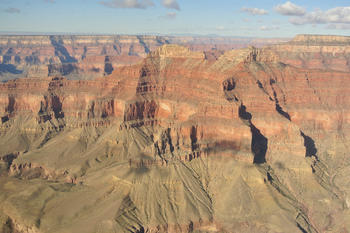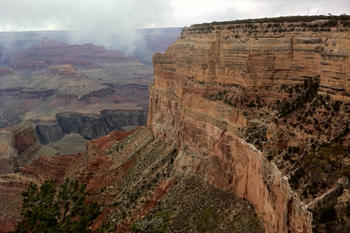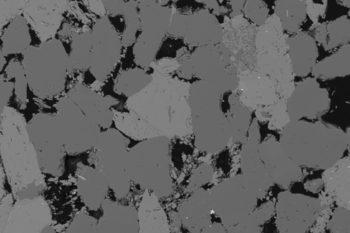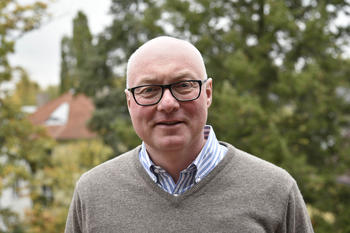Traces in Stone
More ecofriendly, more sustainable: A geophysicist from Freie Universität uses seismic waves to eliminate some exploratory drilling
Mar 02, 2016
A clear view, without drilling: At the Grand Canyon, you can...
Image Credit: Serge Shapiro
... trace about 1.5 billion years of geological development in sedimentary rock.
Image Credit: Serge Shapiro
Raster-Elektronen-Mikroskop-Bild von einem Sandstein. Im Schwarz sind die Porenräume gezeigt. A scanning electron microscope image of sandstone. The pore space is shown in black.
Image Credit: Ramona Niemann
Serge Shapiro is a professor of geophysics at the Department of Earth Sciences at Freie Universität Berlin.
Image Credit: Annika Middeldorf
They can’t talk, but they do offer answers: Geophysicist Serge Shapiro uses seismic waves to coax the secrets out of deep layers of stone. Thanks to his invention, it will not be necessary to drill as much to explore underground reservoirs in the future.
Almost 1,000 meters below Heer Strasse, which runs between Berlin’s districts of Charlottenburg and Spandau, lies the Berlin natural gas reservoir. Up to one billion cubic meters of the fuel can be stored there in sandstone as a strategic reserve for uncertain times. The sandstone layer was discovered in the 1960s, when West Berlin was explored for oil and gas.
But anyone who wants to perform a systematic search for underground reservoirs for natural gas, find fresh water in arid zones, or use geothermal energy has to engage in a process of specific reservoir exploration, in which geologists investigate the properties of the subsoil. What scientists call the “permeability” of the layers of stone is a major factor in this process: If water, oil, or gas is to be brought up to the surface, the layers containing these substances have to be as permeable as possible. By contrast, if the goal is to store waste securely, impermeable material is advantageous
Permeability: An Important, But Hard-to-measure Factor
“Permeability is hard to measure, because the reservoirs are often located as much as five kilometers underground,” explains Shapiro, a professor of geophysics at Freie Universität. It takes a lot of time, effort, and expense to drill for a core sample, and the sample itself only reflects a small section and is not representative of the rock in the surrounding area, Shapiro says.
To solve this problem, Shapiro uses a method in which he has come to specialize: reflection seismology. This method does not require drilling, so it is suitable for exploring larger areas. Even before his 1999 appointment to teach at Freie Universität, Shapiro, who is originally from Russia, worked with seismic waves at research institutions and universities in Moscow, Karlsruhe, and Nancy. These kinds of waves are similar to the ultrasound technology used in medicine; they are emitted from the top and then reflected by the stone layers and structures under the ground. Part of the wave field that is reflected returns to the surface, where it is registered using devices called geophones. The geophones measure the speed at which the seismic waves travel, generally between one and five kilometers per second.
New Computer Models Yield Results
These measurements can then be used to calculate information on various properties of the stone on a computer, including its porosity – the amount of hollow space. The geophysicists can use these data and the results of testing rock samples to determine permeability within a wide radius around the borehole on a highly accurate basis.
When this method delivered good results in initial tests performed by his working group, Shapiro realized that he had made an invention. Together with Profund Innovation, the central service institution for knowledge and technology transfer at Freie Universität Berlin, he developed a patent application to obtain legal protection for the further development of the method and its application. The data from a number of lab experiments are currently being analyzed in order to validate this method. The next step will be to find industry partners to provide Shapiro’s team with seismic data and samples for tests under real-world conditions.
Exploring Reservoirs on a More Sustainable Basis
“This invention can help people to take a more ecofriendly and more sustainable approach to reservoir exploration,” Shapiro explains. It could make it possible to prevent some errors – helping to place development drill holes more precisely to extract fluids, for example – thereby saving time and money. His ideal view of the future: “A consortium of several industry partners jointly purchases a license to use the method and works with us to further develop it.”
This text was originally published in German in campus.leben.




